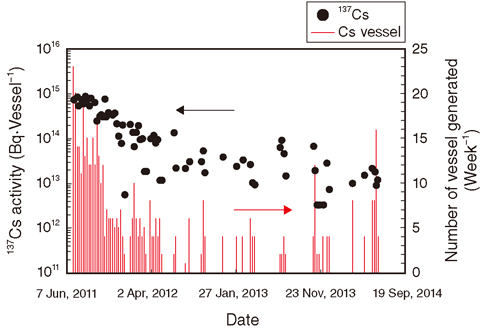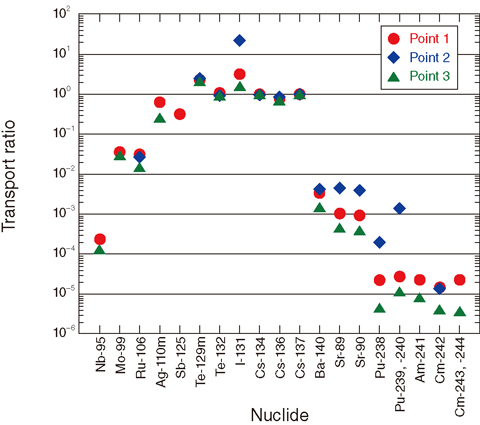
Fig.1-43 Inventory estimation of Cs adsorption vessels

Fig.1-44 Relative extent of transport from the damaged fuel to the soil inside the nuclear power station
Operations for reactor decommissioning and fuel debris retrieval are progressing at the TEPCO’s Fukushima Daiichi NPS. A radioactive inventory is necessary as basic information for appropriate waste treatment and disposal. Accurate inventory estimation is an important development task because it allows more efficient decommissioning. However, the activity of the waste cannot be determined with direct analysis in case sampling waste is difficult, the concentration of activity is very low or other factors inhibit analysis. It is necessary to establish a method for estimating activity in the waste. We are going to introduce achievements based on two approaches.
Cesium (Cs) adsorption vessels, a secondary waste generated from contaminated water treatment, is the first example of waste that is difficult to sample. The contaminated water accumulated in the reactor buildings is decontaminated by devices such as the Cs adsorption device; then, the Cs adsorption vessels or sludge containing radioactivity are generated. These products cannot be analyzed because of their high doses. Therefore, the 137Cs inventory was estimated using the concentrations in the contaminated water upstream and downstream of the Cs adsorption device (Fig.1-43). The sludge inventory was also estimated in a similar way. The analytical values and operational information of the devices were used, and the evaluation period was from the start date of device operation to August 2014. The 137Cs inventory of a weekly-generated Cs adsorption vessel is useful to estimate the total amount of 137Cs decontaminated from the accumulated water. Consequently, it was found that approximately 37% of the 137Cs contained in the reactor fuels of units 1-3 was decontaminated by contaminated water treatment.
Concerning the latter approach for the case of difficult detection, a method based on considering the chemical similarities of elements has been investigated. To obtain basic knowledge about the relationship between contamination behavior and chemical properties radioactivity concentrations analytically determined were investigated for the contamination behavior of some radionuclides. Differences between elements are important and should be quantified; therefore, the ratio of analytical concentrations to the fuel inventory was obtained for normalization, and the resulting ratio was divided by that for the standard nuclide, as defined in the following equation and referred to as a “transport ratio”:
Transport ratio = Ratio of radioactivity concentration for the nuclide of interest and of 137Cs
/Ratio of calculated radioactivity in the fuel for the nuclide of interest and of 137Cs
Transport ratios were calculated for the data in the soil (Fig.1-44). The values for some isotopes were almost identical and it was concluded that the transport ratio indicates elemental behavior. It was found that the order nuclides from greatest to least extent of transport from the damaged fuel was iodine, Cs, silver, strontium, and actinides including plutonium, and that the release of nuclear material was considerably smaller than that of volatile fission products.
These methods will be further investigated and applied to estimating a radioactivity inventory with more reliability.
This topic includes a part of the results of “Establishment of basic technology for decommissioning and safety of nuclear reactors for power generation” in FY 2013 that was entrusted to IRID from METI and conducted by JAEA as a member of IRID.